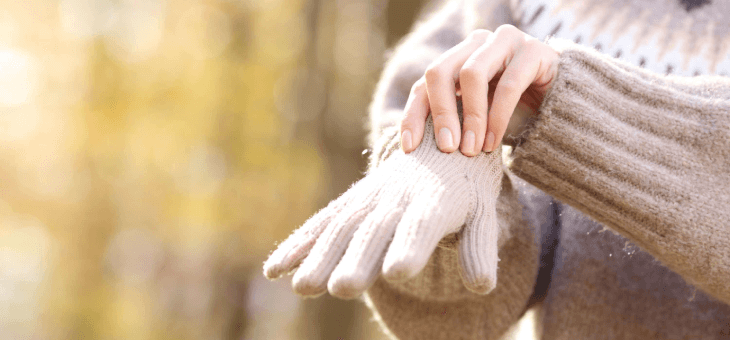We all get cold hands and feet from time to time – especially at this time of year. But sometimes, those chilly extremities are a sign of Raynaud’s disease, which can be very painful.
This is a common condition affecting 5 per cent of the population and occurring predominantly in young women. Yet the charity Scleroderma says around half of adults don’t know any of the signs of Raynaud’s, and millions could be unknowingly living with it and tolerating painful symptoms that could be eased with treatment.
Here’s how the condition can affect people day-to-day, and why it’s important not to dismiss symptoms and to visit your GP if you might be affected.
Read: Are you always cold? It might not be just in your head
“Raynaud’s disease can have a huge impact on day-to-day life,” says Scleroderma and Raynaud’s UK (SRUK) chief executive Sue Farrington. “Simple activities such as reaching for something out of the freezer, or even small changes in the weather can set off painful attacks. Unfortunately, we know many people are likely to brush off symptoms and don’t seek help from their GP.”
Ms Farrington says for some people, Raynaud’s can also be a sign of a more serious underlying condition, such as scleroderma or lupus, and it’s vital for anyone who regularly experiences painful and cold hands or feet to seek help.
“Treatments and support are available to help people manage their Raynaud’s symptoms,” adds Ms Farrington.
Think you might have Raynaud’s? Here’s what you need to know about the condition, according to SRUK.
1. It narrows blood vessels
Exposure to the cold normally makes blood vessels narrower, but when someone has Raynaud’s, the narrowing is more severe in the small blood vessels in the extremities such as the hands and feet. This causes decreased blood flow which can lead to more severe coldness and pain. The narrowing is thought to be caused by disruptions to the nerves that control the blood vessels, making them oversensitive to temperature changes.
2. Raynaud’s disease can make hands and feet change colour
Extremities such as the hands or feet can change colour, from white to blue to red, during a Raynaud’s attack, often when it’s cold.
3. Coldness and numbness
Areas such as fingers and toes will feel cold and numb during a Raynaud’s attack.
Read: Why do I need to pee more in the cold?
4. Tingling and pain
As the circulation returns to the affected areas, people with Raynaud’s may feel tingling or pain in them.
5. It doesn’t just affect hands and feet
Raynaud’s is a condition where the small blood vessels of the fingers become narrow, causing fingers to change colour and become painful. Read about how to treat the symptoms: https://t.co/BtguJhpcLQ pic.twitter.com/G3hIUDaHad
— NHS (@NHSuk) March 9, 2019
As well as the hands and feet, the pain and coldness can also affect the lips, nose, ears and nipples.
6. Stress is also a trigger
As well as exposure to the cold, stress is a known trigger for Raynaud’s attacks.
7. Raynaud’s is more common in women
Although anyone, including children and babies, can potentially get Raynaud’s, the condition is up to four times more likely in women than men, and often starts before the age of 30.
8. There are two types of Raynaud’s
SRUK says most people diagnosed with Raynaud’s will have the ‘primary’ form of the condition, meaning there are no other complications. ‘Secondary’ Raynaud’s is far less common, and means it is caused by another underlying autoimmune condition, such as scleroderma or lupus. People with secondary Raynaud’s are more at risk of serious complications from it, such as ulcers, scarring and even gangrene – but these complications are still rare.
9. It may be hereditary
Raynaud’s could be hereditary, as there may be several cases in the same family. However, many people with primary Raynaud’s don’t have relatives with it and don’t know why they’ve developed the condition.
Read: How cold is too cold? Getting home temperatures right
10. There are treatments
As well as keeping hands and feet warm, SRUK says natural remedies which may help Raynaud’s include ginkgo biloba, ginger, hawthorn, cayenne, magnesium, horse chestnut, dong quai, and prickly ash (always check with your own doctor or pharmacist before introducing new treatments, including over-the-counter supplements). Dietary changes may also be helpful, such as increasing consumption of omega-3 oils and antioxidant vitamins (particularly vitamins C and E), the charity notes.
Prescribed drug treatments can include calcium channel blocker medications, which relax and open the small blood vessels in the hands and feet, vasodilator drugs that relax blood vessels, including Viagra and some antidepressants, beta and alpha-blockers, and ACE inhibitors which help relax blood vessels. Talk to your doctor if your symptoms are getting more severe and impacting your life.
Do you have Raynaud’s? How do you manage it? Let us know in the comments section below.
– With PA
If you enjoy our content, don’t keep it to yourself. Share our free eNews with your friends and encourage them to sign up.
Disclaimer: This article contains general information about health issues and is not advice. For health advice, consult your medical practitioner.

